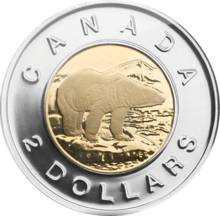Two Dollar Coin (Canada)
| Canada | |
| Value | 2.00 CAD |
|---|---|
| Mass | 6.92 (was 7.30 before 2012) g |
| Diameter | 28 mm |
| Thickness | 1.75 (was 1.8 before 2012) mm |
| Edge | Intermittent milled/smooth |
| Composition |
1996–2011 aluminum bronze, brass plating |
| Years of minting | 1996–present |
| Catalog number | - |
| Obverse | |
 |
|
| Design | Elizabeth II, Her Majesty the Queen in Right of Canada |
| Designer | Susanna Blunt |
| Design date | 2003 |
| Reverse | |
 |
|
| Design | Polar bear in early summer on an ice floe |
| Designer | Brent Townsend |
| Design date | 1996 |
1996–2011
outer ring
99% Ni
inner core
aluminum bronze
(92% Cu, 6% Al, 2% Ni)
2012–
outer ring
steel,
nickel plating
The Canadian two-dollar coin, commonly called the toonie, is the most valuable of the frequently used Canadian coins. It was introduced on February 19, 1996, by Public Works minister Diane Marleau. The toonie is a bimetallic coin which on the reverse side bears an image of a polar bear by artist Brent Townsend. The obverse, like all other current Canadian circulation coins, has a portrait of Queen Elizabeth II. It has the words "ELIZABETH II / D.G. REGINA" in a different typeface from any other Canadian coin; it is also the only coin to consistently bear its issue date on the obverse.
The coin is manufactured using a patented distinctive bimetallic coin-locking mechanism. The coins are estimated to last 20 years. The discontinued two-dollar bill was less expensive to manufacture, but on average each bill lasted only one year.
On April 10, 2012, the Royal Canadian Mint (RCM) announced design changes to the loonie and toonie, which include new security features.
Prior to 2012, the coin consisted of an aluminum bronze inner core with a pure nickel outer ring; but in spring 2012, the composition of the inner core switched to aluminum bronze coated with multiply-plated brass, and the outer ring switched to steel coated with multiply-plated nickel. The weight dropped from 7.30 to 6.92 g, and the thickness changed from 1.8 to 1.75 mm. The Mint states that multiply-plated steel technology, already used in Canada's smaller coinage, produces an electromagnetic signature that is harder to counterfeit than that for regular alloy coins; also, using steel provides cost savings and avoids fluctuations in price or supply of nickel.
...
Wikipedia
